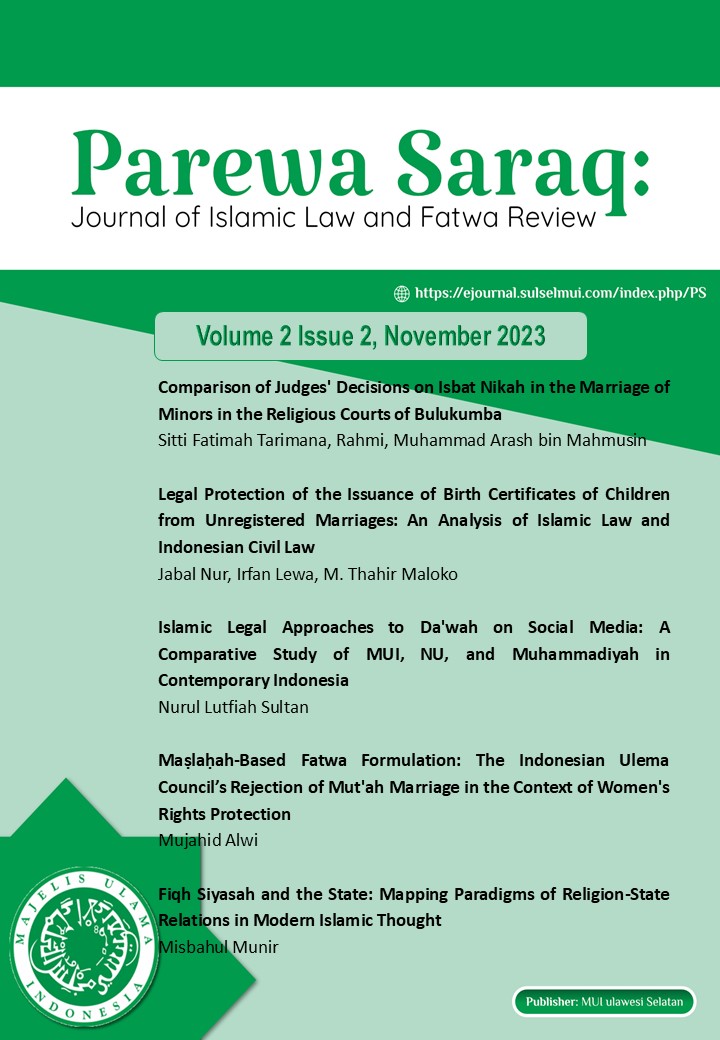Islamic Legal Approaches to Da'wah on Social Media
A Comparative Study of MUI, NU, and Muhammadiyah in Contemporary Indonesia
DOI:
https://doi.org/10.64016/parewasaraq.v2i2.50Keywords:
Digital Da‘wah, MUI, NU, Muhammadiyah, Contemporary FiqhAbstract
The purpose of this study is to examine the methodologies employed by three leading Islamic organizations in Indonesia—Majelis Ulama Indonesia (MUI), Nahdlatul Ulama (NU), and Muhammadiyah—in formulating legal and ethical guidelines for da‘wah on social media. In an era where digital platforms play a crucial role in religious communication, the study seeks to understand how these organizations address contemporary challenges such as misinformation, radicalism, ethical dilemmas, and the commercialization of religious messages. Methodologically, this research adopts a qualitative approach with a literature review design, drawing on scholarly studies, official fatwas, organizational documents, and related academic discussions. The analysis compares the interpretive frameworks and decision-making processes of MUI, NU, and Muhammadiyah to highlight both differences and commonalities in their approaches to digital da‘wah. The results indicate that MUI emphasizes a normative-legal orientation through fatwas and formal guidelines, NU integrates cultural traditions and fiqh principles with inclusivity and moderation, and Muhammadiyah advances a rational and progressive method grounded in tajdīd (renewal) and scientific reasoning. These methodological differences influence the strategies of each organization, shaping the diversity of content and audiences in the digital sphere. The originality of this study lies in its comparative perspective, which systematically juxtaposes the methodological orientations of the three organizations within the context of digital da‘wah. While existing studies often focus on one organization, this research highlights how their combined presence enriches Islamic discourse online. The implications suggest that recognizing these methodological diversities can enhance the effectiveness, inclusivity, and ethical integrity of da‘wah in the digital age, offering valuable insights for scholars, practitioners, and policymakers engaged in promoting constructive religious communication.
References
A. Aziz Masyhuri. (2004). Masalah Keagamaan. PPRMI dan QultumMedia.
Abdullah. (2018). Ilmu Dakwah. RajaGrafindo.
Ahmad, Z. (2004). Tradisi Intelektual NU: Lajnah Bahtsul Masail 1926-1999. LKis.
Alnizar, F., Manshur, F. M., & Ma’ruf, A. (2023). Following the Global Rejection: The Motives of Majelis Ulama Indonesia’s Fatwas on Ahmadiyah. Studia Islamika, 29(3), 519–546. https://doi.org/10.36712/sdi.v29i3.15349
Anshori, I. (2014). Perbedaan Metode Ijtihad Nahdlatul Ulama dan Muhammadiyah dalam Corak Fikih di Indonesia. Nizam, 4(1), 125–139.
Anwar, S. (2012). Metode Penetapan Hukum Dalam Tarjih Muhammadiyah. Lembaga Pengembangan Studi Islam.
Arisandy, D. P., Asmuni, A., & Nasution, M. S. A. (2022). The Majelis Ulama’s Fatwa on Freedom of Expression On Social Media: The Perspective of Maqashid Sharia. Al-Istinbath : Jurnal Hukum Islam, 7(2), 467–486. https://doi.org/10.29240/jhi.v7i2.5235
Azizah, E. (2023). Eksistensi Metode Dakwah Konvensional Pada Era Modern. Jurnal Ilmiah Mandala Education, 9(3), 1736–1744. https://doi.org/10.58258/jime.v9i3.5554
Burhanudin, A. M., Nurhidayah, Y., & Chaerunisa, U. (2019). DAKWAH MELALUI MEDIA SOSIAL (Studi Tentang Pemanfaatan Media Instagram @ cherbonfeminist Sebagai Media Dakwah Mengenai Kesetaraan Gender). Jurnal Dakwah Dan Komunikasi, 10(2), 236–246.
Fauzi. (2023). Dakwah Digital: Peluang dan Tantangan. Komunikasi Islam, v. 10, n.
Fauzin, M. (2022). Strategi Dakwah di Era Digital menurut Lembaga Dakwah PBNU. 12 April 2022.
Hastuti, Asmia, B. R. (2023). Konsolidasi Fatwa MUI dengan Fikih Informasi dalam Merumuskan Etika Bermuamalah di Media Sosial. Jurnal UIN Alauddin Makassar Pendidikan Dan Studi Islam, 9, no.2.
Hootsuite, W. A. S. &. (2024). Digital 2024: Global Overview Report.
Kasiyati, S. (2020). Law Enforcement in Indonesia in Perspective of Transcendental Legal Justice Paradigm. Journal of Transcendental Law, 2(2), 100–114. https://doi.org/10.23917/jtl.v2i2.11855
Kholili, H. M. (2023). Reconceptualization of the Da’wah Movement in Indonesia : Perspectives on Da’wah Communication. Injurity: Interdiciplinary Journal and Hummanity, 2(3), 219–238. https://doi.org/10.58631/injurity.v2i3.40
M. Din Syamsuddin et. al. (2001). Pedoman Penyelenggaraan organisasi Majelis Ulama Indonesia,. Sekretariat MUI.
Mahfuddin, A. (2021). Metodologi Istinbath Hukum Lembaga Bahtsul Masail Nahdlatul Ulama. Jurnal Hukum Keluarga Islam, 6(1), 1–17.
MUI. (2022). Fatwa tentang Pemanfaatan Media Sosial dalam Dakwah. 27 Februari.
Mundzir, M. (2021). Metode Penetapan Fatwa Majelis Ulama Indonesia (Analisis Penggunaan Qawaid Fiqhiyyah sebagai Dalil Mandiri dalam Fatwa). The Indonesian Journal of Islamic Law and Civil Law, 2(1), 1–18. https://doi.org/10.51675/jaksya.v2i1.161
Nuraeni, H. A., & Kurniasih, N. (2021). The Role of Social Media Da’wah in Improving Individual Piety during the Covid 19 Pandemic. Ilmu Dakwah: Academic Journal for Homiletic Studies, 15(2), 343–364. https://doi.org/10.15575/idajhs.v15i2.15734
RI, K. A. (n.d.). Al-Qur’an Dan Terjemahnya. PT. Darma Karsa Utama.
Ridwan, M. (2020). Ijtihad Pada Era Kontemporer (Konteks Pemikiran Islam dalam Fiqih dan Maqashid al-Syariah). Jurnal Masohi, 1(2), 110. https://doi.org/10.36339/jmas.v1i2.356
Sahal Mahfudh. (1994). Nuansa Fikih Sosial. LkiS.
Sayuti, H. (2024). Metodologi Ijtihad & Istinbath Muhammadiyah. Universitas Muhammadiyah Riau.
Utama, A. M. T. (2022). METODE ISTINBATH NAHDLATUL ULAMA (NU): Kajian atas Strategi Fatwa dalam Tradisi Bahts al-Masail di Indonesi. 9, 356–363.
Downloads
Published
How to Cite
Issue
Section
License
Copyright (c) 2023 Nurul Lutfiah Sultan

This work is licensed under a Creative Commons Attribution 4.0 International License.
Authors who publish with Parewa Saraq agree to the following terms:
- Authors retain copyright and grant the Parewa Saraq right of first publication with the work simultaneously licensed under Creative Commons Attribution License (CC BY 4.0) that allows others to share the work with an acknowledgment of the work's authorship and initial publication in this journal.
- Authors can enter into separate, additional contractual arrangements for the non-exclusive distribution of the published version of the work (e.g., post it to an institutional repository or edit it in a book), with an acknowledgment of its initial publication in this journal.
- Authors are permitted and encouraged to post their work online (e.g., in institutional repositories or on their website) before and during the submission process, as it can lead to productive exchanges, as well as earlier and greater citation of published work.








